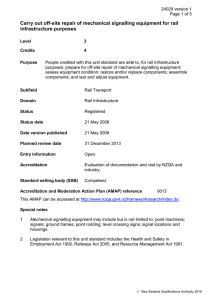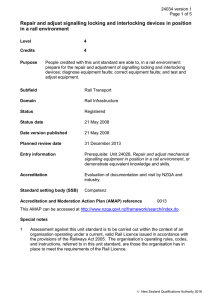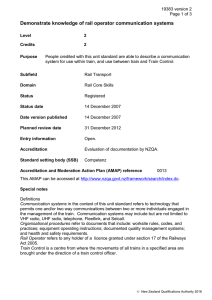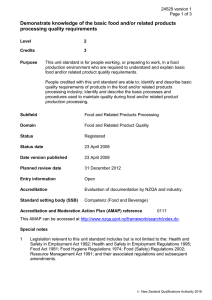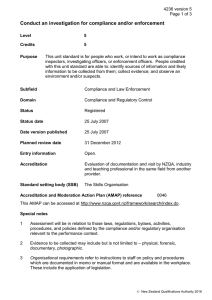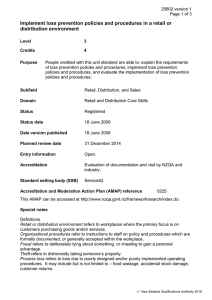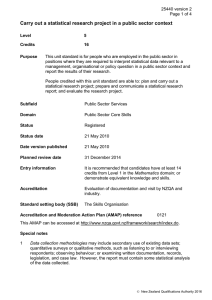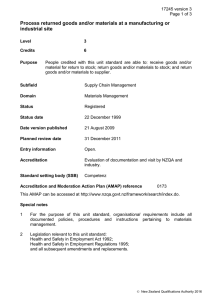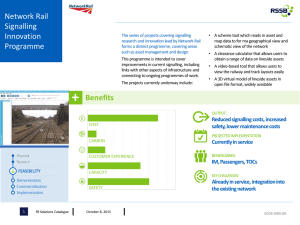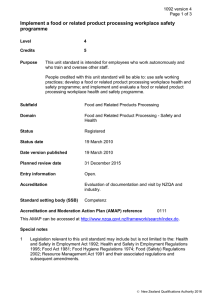Repair and adjust mechanical signalling equipment in position in a... environment
advertisement
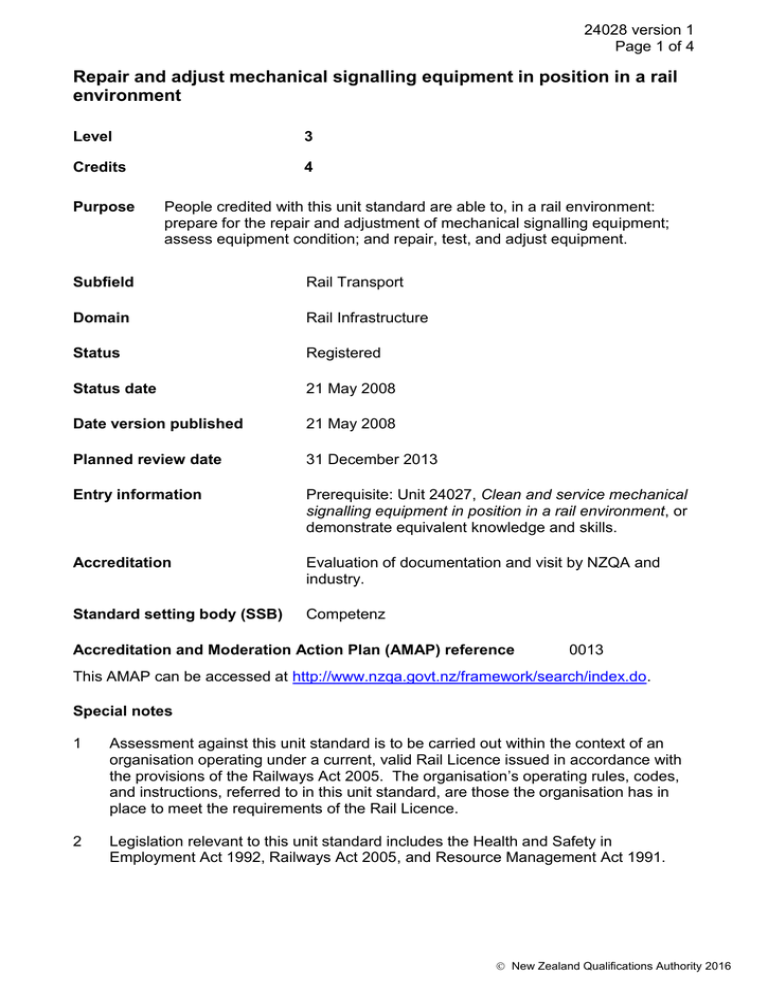
24028 version 1 Page 1 of 4 Repair and adjust mechanical signalling equipment in position in a rail environment Level 3 Credits 4 Purpose People credited with this unit standard are able to, in a rail environment: prepare for the repair and adjustment of mechanical signalling equipment; assess equipment condition; and repair, test, and adjust equipment. Subfield Rail Transport Domain Rail Infrastructure Status Registered Status date 21 May 2008 Date version published 21 May 2008 Planned review date 31 December 2013 Entry information Prerequisite: Unit 24027, Clean and service mechanical signalling equipment in position in a rail environment, or demonstrate equivalent knowledge and skills. Accreditation Evaluation of documentation and visit by NZQA and industry. Standard setting body (SSB) Competenz Accreditation and Moderation Action Plan (AMAP) reference 0013 This AMAP can be accessed at http://www.nzqa.govt.nz/framework/search/index.do. Special notes 1 Assessment against this unit standard is to be carried out within the context of an organisation operating under a current, valid Rail Licence issued in accordance with the provisions of the Railways Act 2005. The organisation’s operating rules, codes, and instructions, referred to in this unit standard, are those the organisation has in place to meet the requirements of the Rail Licence. 2 Legislation relevant to this unit standard includes the Health and Safety in Employment Act 1992, Railways Act 2005, and Resource Management Act 1991. New Zealand Qualifications Authority 2016 24028 version 1 Page 2 of 4 3 Mechanical signalling equipment may include but is not limited to: signals; points equipment; ground frames; level crossing and barrier mechanisms; frames; rods; bars; structures; housings; boxes; signage. 4 Repairs may include but are not limited to: filing; grinding; replacement of components including bushes, pivot pins, gears, and wear plates; welding; mechanical joining. 5 Adjustments may include but are not limited to: processes using designed adjustment components; shimming; and the checking of clearances and tolerances. 6 Repair and adjustment is to be undertaken on at least three occasions, using three different items of mechanical signalling equipment. 7 Operations may: be conducted by day or night in all relevant weather conditions; be conducted in restricted spaces or exposed conditions or controlled or open environments; involve exposure to chemicals, dangerous or hazardous substances and movements of equipment, materials and vehicles. 8 Work is performed under minimal supervision, generally within a team environment. 9 Tools and equipment for repair and adjustment purposes may include but are not limited to: hand and power tools; flood lighting; portable two way radios; air compressors; measuring rules; gauges. 10 Competenz acknowledges the assistance provided by the Transport and Logistics Industry Skills Council in permitting unit of competency TDTB4701A, Repair and Adjust Mechanical Signalling Equipment and Infrastructure to be used as the basis for this unit standard. 11 Definitions In position refers to equipment located in its usual place within the rail network, as opposed to being temporarily off-site in, for example, an engineering workshop or other maintenance facility. Organisational procedures refer to documents that include: worksite rules, codes, and practices; equipment operating instructions; technical specifications; noncompliance reports, documented quality management systems; material safety data sheets (MSDS); maintenance schedules; and health and safety requirements. Elements and performance criteria Element 1 Prepare for the repair and adjustment of mechanical signalling equipment. Performance criteria 1.1 Relevant instructions and information are accessed in accordance with job requirements and organisational procedures. New Zealand Qualifications Authority 2016 24028 version 1 Page 3 of 4 1.2 Work is planned to ensure safe repair activities and minimum disruption to train operations. Range 1.3 may include but is not limited to – rail permissions, track protection, Train Control bulletins, local work schedules, train movements, special circumstances. Personal protective equipment (PPE) is used in accordance with organisational requirements. Range may include but is not limited to – high visibility clothing, hearing protection, gloves, sunscreen, sunglasses, safety glasses, insect repellent, safety headwear, safety footwear, portable radios, hand lamps, flags. Element 2 Assess mechanical signalling equipment condition. Performance criteria 2.1 Non-compliant or non-operating equipment/components are correctly identified through operational testing. 2.2 Viability of adjustments/replacements/repairs to equipment/components is correctly evaluated to ensure cost effective operations. 2.3 Support/assistance with diagnosis or anticipated repair activity is obtained through communication with appropriate personnel. Range communication methods may include but are not limited to – in person, use of two way radios and/or telephones. Element 3 Repair mechanical signalling equipment. Performance criteria 3.1 Equipment and component adjustment is performed in accordance with organisational procedures to ensure required level of operations. 3.2 Equipment and components are repaired or replaced as per organisational procedures to ensure required level of operations. 3.3 Viability of repairs to replaced equipment/components is evaluated, and equipment tagged for repair or disposal is undertaken as per organisational procedures. 3.4 Communication with appropriate personnel is maintained to ensure equipment is maintained within specification. New Zealand Qualifications Authority 2016 24028 version 1 Page 4 of 4 Element 4 Test and adjust equipment. Performance criteria 4.1 All equipment functions are tested in accordance with organisational procedures to ensure operational compliance. 4.2 Final cleaning, lubricating, and adjustments to equipment are carried out to ensure operational compliance. 4.3 Equipment is locked/secured in accordance with organisational procedures to ensure safety and protection from elements and/or persons. 4.4 Records of repair activities are correctly completed and forwarded to appropriate personnel for use in identifying future maintenance requirements. Please note Providers must be accredited by NZQA, or an inter-institutional body with delegated authority for quality assurance, before they can report credits from assessment against unit standards or deliver courses of study leading to that assessment. Industry Training Organisations must be accredited by NZQA before they can register credits from assessment against unit standards. Accredited providers and Industry Training Organisations assessing against unit standards must engage with the moderation system that applies to those standards. Accreditation requirements and an outline of the moderation system that applies to this standard are outlined in the Accreditation and Moderation Action Plan (AMAP). The AMAP also includes useful information about special requirements for organisations wishing to develop education and training programmes, such as minimum qualifications for tutors and assessors, and special resource requirements. Comments on this unit standard Please contact the Competenz qualifications@competenz.org.nz if you wish to suggest changes to the content of this unit standard. New Zealand Qualifications Authority 2016
